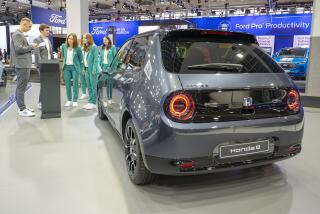Honda’s Hybrid: Comes in Green, Batteries Included
- Share via
WASHINGTON — Honda has seen the future and it is the hybrid, a brave new stopgap that promises to give our damaged lungs and sooty cities a little more breathing room.
Honda calls its little savior Insight, that title being an acceptable flourish of self-congratulation for a company and a two-seater targeting an ecological closet stuffed with several million Americans concerned about the environment--but who are not quite ready for a full commitment to the high cost, low range and recharging inconveniences of electric cars.
With the Insight, they have it both ways and can make a social contribution without suffering the compromises. One half of the hybrid is an electric motor to satisfy the greens and Southern California Edison. The other portion of the mechanical partnership is an ultra-low-emissions engine that doesn’t put out enough poisonous gases to allow suicide in a closed garage with the exhaust pipe up one nostril.
Among the car’s other minor miracles is a potential range of 700 miles, or about twice the distance any traveler’s urological plumbing comfortably allows. Economy fanatics prepared to slipstream 18-wheelers, and drive in bare feet with an egg beneath the gas pedal, could record 70 miles per gallon on the highway, a figure typically associated with motor scooters and lawn mowers and Honda publicists.
Such are the encouragements of the Insight, an aluminum-rich compact that weighs only about 1,900 pounds and flashes an aerodynamic shape good for a coefficient of drag of just 0.25. That’s lighter than the lightest, a Chevy Metro, and almost as slippery as the slickest, General Motors’ all-electric EV1.
“It is the next move, a very significant step, a starting point, the first step toward other types of propulsion,” says Tom Elliott, executive vice president of Torrance-based American Honda Motor Co.
He said the car could be as historic as aviation’s transition from piston engines to jets. Others at last month’s Insight introduction at the International Trade Center in Washington groped for meatier comparisons. As big as switching from typewriters to personal computers. The change from silent movies to talkies. Radio to television. Plain vanilla to English toffee ice cream. One small step for Honda, one giant stride for getting from A to B without leaving smoggy fingerprints.
“We’ve tested the electric vehicles, which, as far as consumers are concerned, have certain shortcomings,” Elliott continues. “Now it’s the hybrid, with Insight in its infancy. Do consumers like it? What don’t they like about it? They will help us shape hybrids for the future.”
And that future, he says, will obviously include hydrogen-electric fuel-cell propulsion in the decade to come. But with hybrids becoming more sophisticated during those 10 years, and possibly spreading their technology to mid-size and luxury cars. Even sports cars. Although Ferrari is unlikely to be depressed by such a prospect.
*
Here’s how it all works:
The Insight’s insides include a small, relatively conventional, three-cylinder internal-combustion engine. It displaces only 1.0 liter and produces just 67 horsepower. Or less huff and grunt than a Harley-Davidson.
Bolted directly to the crankshaft is an electric motor that transforms engine energy into electric power, which feeds a bank of nickel-metal-hydride storage batteries capable of delivering 144 volts. Also an additional eight horsepower. It’s a parallel setup with both gasoline and electric engines driving the front wheels of the car.
As a shortcut to complete understanding, see the Insight’s electric motor as nothing more than a supercharger--but one generating clean, auxiliary electrical power to improve performance. That is, instead of boosting horsepower by forcing air into the engine, which destroys gas consumption, increases exhaust gases and produces letters to the editor from Ed Begley Jr.
The Insight does not have to be attached to an outlet at home or plugged into a wall at LAX or tethered outside your nearest Safeway EV recharging station overnight to replenish its batteries. They are rejuvenated automatically and continuously by engine power and the regenerative energies of braking and coasting.
Hybrids, of course, are not that new. Toyota’s Prius has been whizzing around Japan for almost two years and will go on sale in the United States next June. A government-industry research program called Partnership for a New Generation of Vehicles, or PNGV, has Ford, General Motors and DaimlerChrysler building concept cars powered by small diesel engines and electric motors. This month, as part of a federal research contract, Ford will deliver a mid-size gasoline-electric hybrid prototype to the Department of Energy.
*
But for the time being, the hybrid arena belongs to Honda and the Insight, which will be in showrooms by December.
Despite almost copycat propulsion systems, and pricing estimated at below $20,000, there are significant differences between the Prius and the Insight that could decide whether you buy now or wait until next summer.
The Prius is a four-door with room for four bodies. It has an automatic transmission and, when traveling slowly, moves on electric power alone. The engine is a 1.5-liter, 58-horsepower four-banger.
The Insight, as noted, is a 1.0-liter three-lunger. It is a coupe with room for a couple. The only transmission is a five-speed manual, but Honda says it is working on an automatic.
Although the gasoline engine cuts out when the car is glued stationary in morning traffic on the Hollywood Freeway--further reducing noxious emissions--every movement at any speed at all times is by combined gasoline-electric power. And dipping the clutch when traffic starts to budge creates an automatic restart in a tenth of a nanosecond.
Rear-wheel pants and a squared-off back give a futuristic flair to the Insight’s styling. There’s a bit of CRX there. Quite cute but only marginally handsome. The front, from hood through fenders and grille, is all slopes and rounds and typically Honda Civic.
So is the interior, which if it weren’t for digital readouts showing the charge rate and amount of juice in the battery pack would be confused with the mostly gray, basic black and plasticky cabin of every subcompact on the market.
*
And so is a performance profile that is several glimmers shy of dazzling. Expect to take 12 seconds from rest to 60 mph and anticipate a top speed of 104 mph, which won’t exactly bring blood to your eyeballs. Mid-range acceleration, no matter how vigorous your downshifting, is a dawdle that only seems to break into a canter when horsepower starts to peak around 5,000 revolutions per minute. Once up on that step, however, this little car just keeps running and rolling at freeway speeds without breaking much of a sweat.
Handling, steering, ride quality, cabin quiet and braking are also down in the bargain basement with the Toyota Corolla and Hyundai Accent--although slinging the Insight around isn’t highly recommended, owing to skinny Bridgestone tires built to reduce rolling resistance, not amplify grip.
Still, the Insight is an acceptable, responsible, affordable and practical start on dismantling an ogre in our midst.
And certainly a clean beginning.
Times automotive writer Paul Dean can be reached at dixiedean27@aol.com.
(BEGIN TEXT OF INFOBOX / INFOGRAPHIC)
2000 Honda Insight
Cost
* Base (estimated) below $20,000; includes air bags, power steering, AM-FM radio with tape deck, anti-lock brakes, alloy wheels, remote entry system, power windows and door locks--but no ashtray, no CD, no automatic transmission. Air conditioning is the only option.
Engine
* 1.0-liter, three-cylinder, gasoline engine developing 67 horsepower. Also 10-kilowatt permanent-magnet electric motor.
Type
* Front-engine, front-drive, gasoline-electric hybrid.
Performance
* 0 to 60 mph (manufacturer’s estimate): 12 seconds.
* Top speed (manufacturer’s estimate): 104 mph.
* Fuel consumption (as certified by the Environmental Protection Agency): 61 miles per gallon city, 70 mpg highway. As tested, closer to 58 mpg city and highway.
Curb Weight
* 1,887 pounds
The Good: First mass-
production hybrid vehicle to address environmental downside of motoring in America. Affordable, with impressive fuel consumption. Sensible alternative to buying an electric vehicle and certainly a car that will interest the uncommitted.
The Bad: Real-world test mileage not quite up to optimistic estimates of Honda. Steering wheel from Honda S2000 roadster is the car’s only expression of high performance.
The Ugly: Your call on the rear end.






